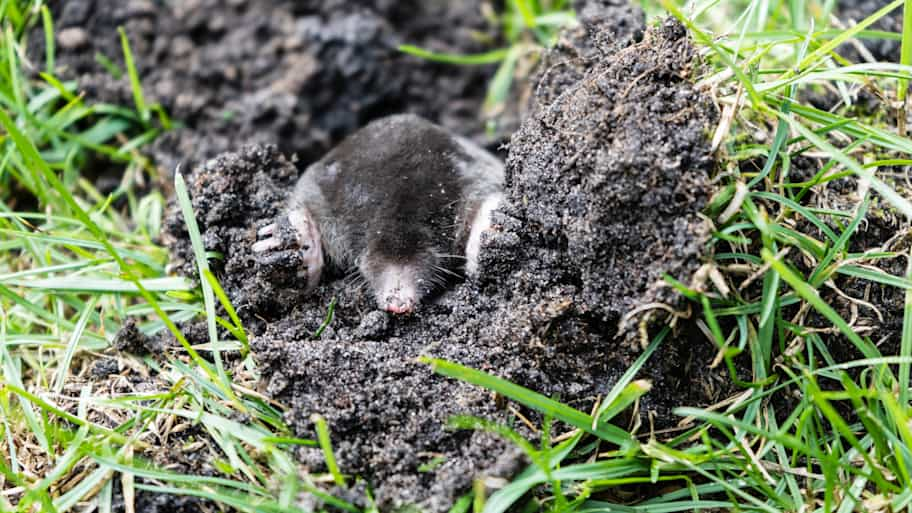
The cost to remove a groundhog can vary depending on where you live and whether you do it yourself or hire a professional. We’ll help you figure out the true cost of groundhog removal, along with strategies for humane trapping and release.
Spotting the signs is easier than winning a game of “Whac-a-Mole”


Molehills are small dirt mounds less than 6 inches tall.
Moles can dig tunnels 6 to 24 inches deep.
Moles can tunnel up to 150 feet per day.
Noise, certain plants, and mesh barriers can help deter moles.
Pro mole removal costs $100 to $550.
For homeowners who take pride in their lawn and garden, moles can quickly become a major source of frustration. These creatures may look innocent, but they can wreak a lot of havoc on a lawn as they search for food. So, how do you know if these pests are taking over your property? Look for these five common signs of moles in a yard.

You may not see a mole itself, but these nocturnal creatures leave behind many signs that they were in your yard.
One very clear sign of moles in your yard is visible tunnels or ridges popping up along your grass or garden. While moles can dig down 24 inches into the ground while they seek food, they’re likely to start more shallow, around 6 inches deep. They will displace the soil, leaving raised ridges that wind around the lawn.
Moles push soil out of the way to make tunnels, which can leave soil feeling soft and squishy underfoot. Look for loose soil around the lawn or feel for soft soil if you suspect moles in the yard.
There are lots of root causes of higher-than-usual weed growth, but more weeds in your lawn could be a sign of moles in your yard. Moles can tunnel up to 150 feet in length per day, which uproots your grass or garden plants and makes more space for weeds.
Since these animals dig and tunnel, moles can leave a lot of damage in their wake. Their movements will damage grass roots directly above their tunnels, which can then lead to yellow or brown grass patches on your lawn.
One of the most obvious signs of moles is the presence of molehills, or small dirt mounds where the moles exit their tunnels. These mounds are small, no higher than 6 inches. You may also notice raised ridges that travel away from the mound.
But wait, how do you know whether those mounds are from a mole versus a gopher? Mole mounds are raised, resembling little volcanoes, while gopher holes are flatter and crescent-shaped.

To get rid of moles in your yard, start by limiting their food access. Moles are attracted to grubs, so start by getting rid of grubs with treatments like beneficial nematodes, milky spores, neem oil, or commercial pesticides.
Consider planting mole-repelling plants, like alliums and daffodils, and dig a trench to lay mesh around the perimeter of your property to deter moles. If you’ve tried removing their food source, laying barriers, and using repellents, it’s time to call an expert for professional trapping.
Like with any wild animal, trapping moles is best left to the pros. Improper trapping could injure you or harm the animal. Hire a wildlife control pro near you to safely, ethically remove the moles in your yard and release them elsewhere.
It may not be enough to trap and release the moles. You’ll also want to take some precautions to keep them from returning and stop new moles from popping up in your lawn. Here are a few easy ways to prevent moles from tunneling in your yard and garden:
Control grubs: Use natural control methods or pesticides to keep grubs out of your yard. Grubs will damage your grass on their own, so prevention will save your grass from grub and mole damage.
Get noisy: Noise and movement can frighten moles and deter them. Add reflective pinwheels and other garden decor, add a wind chime to your patio, or invest in an ultrasonic sound repellent (so long as you don’t have pets).
Apply mole repellent: Commercial products, like sprays or repellents, are designed specifically to deter moles. Apply mole repellent in early spring and again in early fall. Consider refreshing the repellent after heavy rain.
Install mesh: Place a mesh barrier under your garden or around your property to prevent moles from digging.
Hiring a mole exterminator costs $100 to $550 on average. A pro will be able to most effectively and quickly get the mole problem under control. You can save money by trying some DIY treatments, but keep in mind that the longer the moles spend in your yard, the more damage they can do (and fast).
From average costs to expert advice, get all the answers you need to get your job done.

The cost to remove a groundhog can vary depending on where you live and whether you do it yourself or hire a professional. We’ll help you figure out the true cost of groundhog removal, along with strategies for humane trapping and release.

When calculating fox removal costs, factor in whether you take a DIY approach or call in the pros, the number of animals involved, and the location.

Raccoons on your property can cause a lot of damage to your home and yard. This guide breaks down raccoon removal costs so you can budget accordingly.
Not sure how to get rid of animals in your attic? Get comprehensive tips to identify what’s up there and how to send them packing from your home.

Want to get rid of a bird’s nest on or around your home? Learn what your options are to remove an old inactive nest near your property.

If your yard is filled with holes, we can teach you how to get rid of gophers and keep them away from your property so you can restore your landscape.